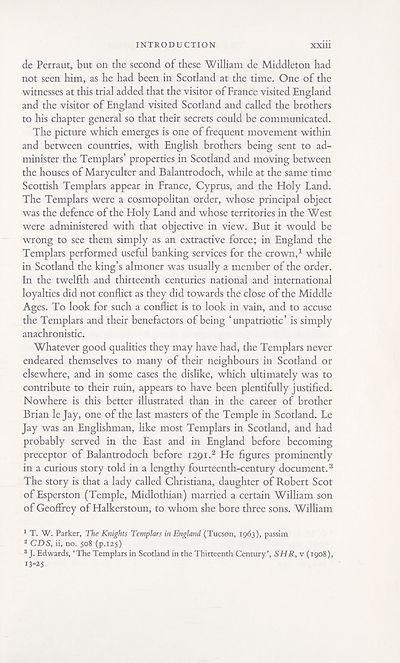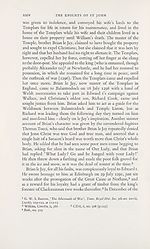Series 4 > Knights of St John of Jerusalem in Scotland
(28) Page xxiii
Download files
Complete book:
Individual page:
Thumbnail gallery: Grid view | List view

INTRODUCTION
xxiii
de Perraut, but on the second of these William de Middleton had
not seen him, as he had been in Scotland at the time. One of the
witnesses at this trial added that the visitor of France visited England
and the visitor of England visited Scotland and called the brothers
to his chapter general so that their secrets could be communicated.
The picture which emerges is one of frequent movement within
and between countries, with English brothers being sent to ad¬
minister the Templars’ properties in Scotland and moving between
the houses of Maryculter and Balantrodoch, while at the same time
Scottish Templars appear in France, Cyprus, and the Holy Land.
The Templars were a cosmopolitan order, whose principal object
was the defence of the Holy Land and whose territories in the West
were administered with that objective in view. But it would be
wrong to see them simply as an extractive force; in England the
Templars performed useful banking services for the crown,1 while
in Scotland the king’s almoner was usually a member of the order.
In the twelfth and thirteenth centuries national and international
loyalties did not conflict as they did towards the close of the Middle
Ages. To look for such a conflict is to look in vain, and to accuse
the Templars and their benefactors of being ‘unpatriotic’ is simply
anachronistic.
Whatever good qualities they may have had, the Templars never
endeared themselves to many of their neighbours in Scotland or
elsewhere, and in some cases the dislike, which ultimately was to
contribute to their ruin, appears to have been plentifully justified.
Nowhere is this better illustrated than in the career of brother
Brian le Jay, one of the last masters of the Temple in Scotland. Le
Jay was an Englishman, like most Templars in Scotland, and had
probably served in the East and in England before becoming
preceptor of Balantrodoch before 1291.2 He figures prominently
in a curious story told in a lengthy fourteenth-century document.3
The story is that a lady called Christiana, daughter of Robert Scot
of Esperston (Temple, Midlothian) married a certain William son
of Geoffrey of Halkerstoun, to whom she bore three sons. William
1 T. W. Parker, The Knights Templars in England (Tucson, 1963), passim
2 CDS, ii, no. 508 (p.125)
8 J. Edwards, ‘The Templars in Scotland in the Thirteenth Century’, SHR, v (1908),
I3-2J
xxiii
de Perraut, but on the second of these William de Middleton had
not seen him, as he had been in Scotland at the time. One of the
witnesses at this trial added that the visitor of France visited England
and the visitor of England visited Scotland and called the brothers
to his chapter general so that their secrets could be communicated.
The picture which emerges is one of frequent movement within
and between countries, with English brothers being sent to ad¬
minister the Templars’ properties in Scotland and moving between
the houses of Maryculter and Balantrodoch, while at the same time
Scottish Templars appear in France, Cyprus, and the Holy Land.
The Templars were a cosmopolitan order, whose principal object
was the defence of the Holy Land and whose territories in the West
were administered with that objective in view. But it would be
wrong to see them simply as an extractive force; in England the
Templars performed useful banking services for the crown,1 while
in Scotland the king’s almoner was usually a member of the order.
In the twelfth and thirteenth centuries national and international
loyalties did not conflict as they did towards the close of the Middle
Ages. To look for such a conflict is to look in vain, and to accuse
the Templars and their benefactors of being ‘unpatriotic’ is simply
anachronistic.
Whatever good qualities they may have had, the Templars never
endeared themselves to many of their neighbours in Scotland or
elsewhere, and in some cases the dislike, which ultimately was to
contribute to their ruin, appears to have been plentifully justified.
Nowhere is this better illustrated than in the career of brother
Brian le Jay, one of the last masters of the Temple in Scotland. Le
Jay was an Englishman, like most Templars in Scotland, and had
probably served in the East and in England before becoming
preceptor of Balantrodoch before 1291.2 He figures prominently
in a curious story told in a lengthy fourteenth-century document.3
The story is that a lady called Christiana, daughter of Robert Scot
of Esperston (Temple, Midlothian) married a certain William son
of Geoffrey of Halkerstoun, to whom she bore three sons. William
1 T. W. Parker, The Knights Templars in England (Tucson, 1963), passim
2 CDS, ii, no. 508 (p.125)
8 J. Edwards, ‘The Templars in Scotland in the Thirteenth Century’, SHR, v (1908),
I3-2J
Set display mode to:
![]() Universal Viewer |
Universal Viewer | ![]() Mirador |
Large image | Transcription
Mirador |
Large image | Transcription
Images and transcriptions on this page, including medium image downloads, may be used under the Creative Commons Attribution 4.0 International Licence unless otherwise stated. ![]()
| Scottish History Society volumes > Series 4 > Knights of St John of Jerusalem in Scotland > (28) Page xxiii |
|---|
| Permanent URL | https://digital.nls.uk/126637851 |
|---|
| Description | Over 180 volumes, published by the Scottish History Society, containing original sources on Scotland's history and people. With a wide range of subjects, the books collectively cover all periods from the 12th to 20th centuries, and reflect changing trends in Scottish history. Sources are accompanied by scholarly interpretation, references and bibliographies. Volumes are usually published annually, and more digitised volumes will be added as they become available. |
|---|


